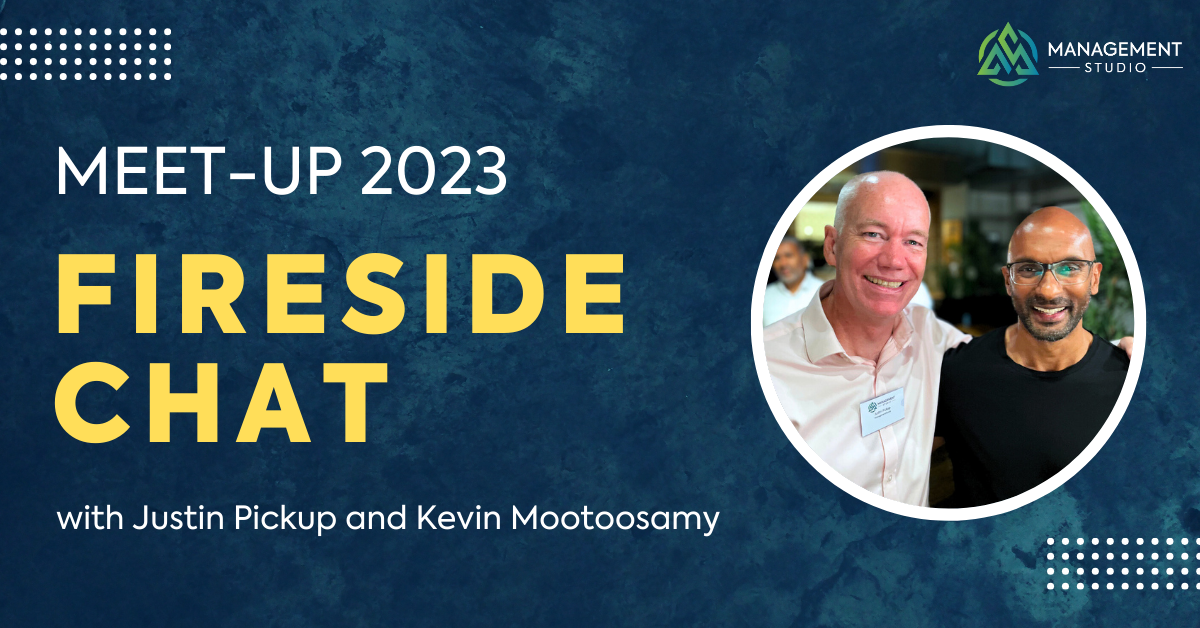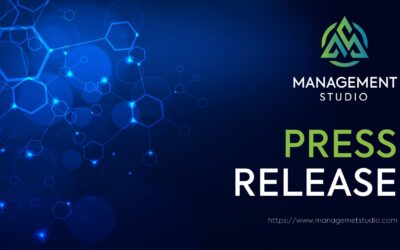Transforming the Financial Landscape
In the fast-paced world of finance, adaptability and efficiency are key drivers of success. Lloyd’s Bank, one of the stalwarts of the financial industry, has demonstrated these qualities in abundance through its partnership with ManagementStudio. During Meet-up 2023, our founder, Justin Pickup, sat down with Kevin Mootoosamy (Programme Lead at Lloyds Bank) to get an exclusive look at how ManagementStudio has revolutionised the way Lloyd’s Bank manages its complex projects and data sources.
Kevin, who has been with Lloyd’s Bank for a decade, provides a comprehensive account of how their journey began. The story starts with a company-wide Windows 7 migration, involving a staggering 120,000 devices, a testament to the bank’s scale. At that time, they relied on AppTracker to streamline their efforts, but it was no walk in the park. Kevin recalls the challenge of managing such a vast amount of data:
We had a huge army of people to manage a lot of the data that was coming in, because we were sending out surveys to pretty much every single user and those surveys had to be assessed. It was quite time consuming.
The real turning point came when Lloyd’s Bank was entrusted with the M365 migration efforts. This ground-breaking programme, one of the first to roll out the Microsoft Managed Desktop (MMD) globally, encompassed many large projects, including Windows 10 migrations, branch migrations, virtual migrations to Azure, Exchange migrations, and OneDrive migrations. To efficiently handle this, the team integrated their existing scripts into ManagementStudio, allowing them to streamline their communication and improve data tracking.
That’s when the exciting stuff happened at Lloyds… When Microsoft came in, they actually said, “if you could migrate Lloyd’s, you’d be able to migrate anything globally”. It’s such a complicated environment. It’s made up of a number of different financial institutions.
The introduction of automated communications, particularly multi-surveys, became a game-changer for Lloyd’s Bank. The multi-survey feature facilitated seamless management of multiple projects. These surveys, a crucial part of the project, provided valuable data, which ManagementStudio helped analyse effectively.
The Automation Revolution
The conversation with Kevin then dives into automation’s pivotal role. ManagementStudio brought a significant shift by reducing manual processes within the bank. From sending data to different teams to managing user groups in Active Directory, all of it became fully automated. Notably, Kevin emphasises the seamless execution of the Azure virtual migrations, with the entire process being fully automated, reducing the scope of manual touchpoints.
Kevin also highlights the “if this, then that” type of automation, demonstrating ManagementStudio’s flexibility. This system allowed them to streamline complex processes, resulting in remarkable efficiency.
It’s cut down on the number of processes – the manual processes – that Lloyds have had to do. Sending data out to different teams, putting users into AD groups, removing users from AD groups; all of that is fully automated.
Mentoring for Success
ManagementStudio’s influence extended to mentoring as well. Kevin praised the mentoring programme led by Dave Coopey, emphasising its role in their successful transition to ManagementStudio. Their weekly catch-up sessions have played a significant part in managing multiple concurrent projects.
Becoming a Project Hub
What makes this story even more remarkable is how Kevin’s team has evolved into a project hub within the organisation. After completing the Windows 7 migration, they didn’t simply wrap things up. Instead, they capitalised on the wealth of data stored in ManagementStudio, which includes Active Directory, SCCM, Azure, Intune, HR records, and ServiceNow, among other sources. This centralised data source has transformed the way projects operate at the bank, eliminating the need to delve into multiple data sources for information.
ManagementStudio has enabled Kevin and his team to extract specific data from these sources and utilise it for various projects. This centralised approach has streamlined and expedited project management significantly.
Diverse Projects
Kevin now manages six to seven projects concurrently in ManagementStudio, ranging from an Active Directory migration, Windows Hello deployment, Windows 10 migration in New York, to the large Citrix migration to Azure. The case of Citrix stands out, as Kevin explains how ManagementStudio helped them identify users of Citrix efficiently, reducing the scope of users and automating the migration process.
[We] found some huge benefits in using ManagementStudio. They were having trouble basically identifying Citrix users in the estate and who was using Citrix.
But where we were putting data into ManagementStudio for the Citrix farms, we were able to kind of analyse the data quite quickly and understand who’s using Citrix and who wasn’t using Citrix. We quickly reduced the scope down from like 15,000 users to like 10,000 users because we knew who wasn’t using Citrix.
We sent out comms to those users automatically to say, “hey, we’re going to remove you from Citrix”. By the end of this users came back to us and we just removed AD groups and we cut down the scope quite quickly.
The rest of the users on Citrix, we’ve got a t-minus process; we send them comms, particular things happen and get added to AD groups, etc, etc. And then we spin up a multi-user device in Azure and we assign that to the users. So again, it’s a fully automated process that we undertake, hardly any manual touch points. It’s fantastic!
Consulting Beyond Lloyd’s Bank
What’s more, Kevin and his team have recognised the broader potential of ManagementStudio. They have ventured into consultancy services, collaborating with other organisations to help them harness the power of the tool for their projects. This approach is transforming the way projects are undertaken, making processes more efficient, and requiring fewer resources.
Instead of putting people out and undertaking migrations and deployments manually, actually using a tool, such as ManagementStudio, it just makes everyone’s lives easier and much more efficient. You need less resources, we could just run migrations and deployments just with the core team, which we’ve proven outright.
The Future
As the interview concludes, the future looks bright for Kevin’s team, with ManagementStudio continuing to play a pivotal role in their projects. The philosophy of “land and expand” has opened new doors, bringing opportunities for Kevin to share his team’s expertise with other organisations. This dynamic partnership exemplifies how cutting-edge technology can empower financial institutions to streamline operations, become more efficient, and maintain their competitive edge in a rapidly evolving industry.
Read the Full Interview
JP: So I’d like to introduce you to Kevin Mootoosamy. Kevin works at Lloyd’s Bank. Lloyd’s Bank is one of our longest running customers and probably one of our biggest customers as well in terms of assets and people.
KM: I’ve been working at Lloyds Bank now with ManagementStudio for 10 years now. I’ve had a number of roles with Lloyds Bank. I started using AppTracker on the Windows 7 programme. So to put it into perspective, it’s quite relatively big, as Justin says, a relatively big estate. We got, when we were migrating Windows 7, 120,000 devices, 20,000 devices in branches, 20,000 virtual devices. So here we relied on AppTrackerer, and now we’re doing multiple projects.
JP: So we went from AppTracker where it’s just applications then into MigrationStudio. In terms of that project – you said there was 120,000 people to be migrated – how did you specifically manage that? MigrationStudio was a single-project tool at the time and you brought on a team of people.
KM: Yeah, it was. In the AppTracker days it was quite difficult. We ran a lot of scripts outside of AppTracker. We had, back then, SCCM and Active Directory coming into AppTracker. To be honest, it was quite difficult. We had a huge army of people to manage a lot of the data that was coming in, because we were sending out surveys to pretty much every single user and those surveys had to be assessed. It was quite time consuming.
JP: And of course there was only one survey available. So then what’s happening? You’ve finished the Windows 7 migration and then you’ve upgraded to ManagementStudio.
KM: So I guess that’s when the exciting stuff happened with Lloyd’s. So we were asked to look after the M365 migration efforts of Lloyd’s. Microsoft came in and we were one of the first companies to actually roll out MMDs – the Microsoft managed desktop – in the world.
When Microsoft came in, they actually said, if you could migrate Lloyd’s, you’d be able to migrate anything globally. It’s such a complicated environment. It’s made up of a number of different financial institutions.
The number of devices fell a little bit. We were sitting at around 90, 000 devices. Virtual devices stayed the same, around 20, 000 virtual devices. But it was quite a perfect project. It took around three years to complete but it was a whole Microsoft stack. We’re talking about those Windows 10 migrations, physical migrations, branch migrations, virtual migrations – that was virtual devices over to Azure.
We did the Exchange migrations as well; all mailboxes were migrated from physical on-prem Exchange over to the cloud, OneDrive migrations for every single user. We ran a few scripts outside of MigrationStudio as it was then but all of that data is basically plugged into MigrationStudio and then it was all analysed in MigrationStudio.
JP: It was a case of you using the consistent data pool. So you were making use of that data to run those different exchange migrations, M365, and all that sort of stuff. And then, when those finished, we launched ManagementStudio just at the end of one of your major projects. On the upgrade, we kept the data, but we upgraded the product into ManagementStudio. How did things change then? What happened? Because you’ve still got some of your team from the coding perspective but what changed in the way you were using the controls of ManagementStudio?
KM: A lot of the scripts that we developed outside of MigrationStudio were now integrated into Management Studio. I think one of the biggest benefits is comms. We were able to kind of track coms a lot better in ManagementStudio.
JP: You’re using the automated comms?
KM: Correct
JP: So emails as well as multi survey?
KM: Oh, multi-survey has been a game changer for us, especially with multi-projects. Being able to send out different surveys is a huge benefit for us.
JP: And what happens to all that data? Are you using that as the focal point of your controls in terms of automation so you’re now managing to automate the repetitive processes?
KM: Yeah, yeah, absolutely. The automation is great but it’s cut down on the number of processes – the manual processes – that Lloyds have had to do. Sending data out to different teams, putting users into AD groups, removing users from AD groups; all of that is fully automated.
I mean if you look at what we did on say the Azure virtual migrations, that was end to end, a completely automated service that we gave them. We literally migrated 20,000 devices and fully automated everything. We spun up devices in Azure, we gave devices out to users. Literally just one button that was pressed. Users were scheduled, comms were sent out and a device, a virtual device, was put in front of the user.
JP: And that’s all using the ESM, “if this, then that” type of automation.
And also you’ve taken up the mentoring with Dave. Has that worked in your favour as well?
KM: Absolutely, especially when moving to ManagementStudio. Yeah, the mentoring is great, we have a weekly catch up with Dave. I mean we’re running like six or seven concurrent projects now in ManagementStudio.
JP: So tell us about those projects. Basically, you were shutting down MigrationStudio and it was going to be a mop up. Thank you very much. See you later. And you stepped in and said actually, we can use this data for a number of projects. So then what did you do? You went out to the business team.
KM: Yeah, exactly. So I knew the power of ManagementStudio, and I knew what we could do with the data sources that we got in ManagementStudio at the moment. We’ve got obviously Active Directory, I think we still have SCCM somewhere, we’ve got Azure, we’ve got Intune, we’ve got HR records, we’ve got ServiceNow, and there’s a few other bits and pieces that we’ve put into ManagementStudio.
And to be honest, there’s no other place within Lloyds that has that kind of data all in one place. What we’re finding is that the projects that use ManagementStudio no longer have to delve into these different data sources.
Because ServiceNow, as you all know, is like huge, right? And to get some data in ServiceNow, sometimes you’ve got to dig into that ServiceNow data. What we’ve done with some projects is say, hey, what do you need in ServiceNow?
And we’ve kind of extracted that data from ServiceNow, plugged it into ManagementStudio. So, it’s a beautiful source of that data.
JP: So now your team has become a project hub?
KM: We’ve become a project hub.
JP: And you were going to say, I think before I distracted you, you were going to tell us about some of those projects that you did.
KM: Yeah, so I think there are six or seven projects that we’re managing now. We’re doing an Active Directory migration – there are a couple of domains that are moving into one of our major domains in Lloyd’s.
We’re doing Windows Hello, we’re rolling that out across the whole estate.
We are doing a small migration in New York, that’s a Windows 10 migration.
Citrix migration is a big one – Citrix over to Azure, multi -users…
JP: Tell us a little more about Citrix
KM: Citrix, yeah, that’s a good one that we’re doing. They found some huge benefits in using ManagementStudio. They were having trouble basically identifying Citrix users in the estate and who was using Citrix.
But where we were putting data into ManagementStudio for the Citrix farms, we were able to kind of analyse the data quite quickly and understand who’s using Citrix and who wasn’t using Citrix. We quickly reduced the scope down from like 15, 000 users to like 10, 000 users because we knew who wasn’t using Citrix.
We sent out comms to those users automatically to say, “hey, we’re going to remove you from Citrix”. By the end of this users came back to us and we just removed AD groups and we cut down the scope quite quickly.
The rest of the users on Citrix, we’ve got a t-minus process, we send them comms, particular things happen and get added to AD groups, etc, etc. And then we spin up a multi-user device in Azure and we assign that to the users. So again, it’s a fully automated process that we undertake, hardly any manual touch points. It’s fantastic!
JP: And it’s great to see you so enthusiastic as well. And what that spurred on, actually, is you’ve kind of understood the whole philosophy from a consultancy perspective, that land and expand. And now you’re kind of branching out into doing consultancy on ManagementStudio. So you’re looking to actually consult with other companies on a similar size, in terms of showing them how they can use that data going forward within other companies. So it’s not just a one -shot product. It’s now something that you can use over and over again for smaller projects.
KM: I mean, on my team, we’ve been around a number of different banks, financial institutions, and we’ve undertaken a number of different migrations and deployments. I mean, just using this tool, it’s just made our lives much easier.
What we’ve done is we’ve now created our work consultancy and work, obviously, very closely with you guys, working in other organizations with ManagementStudio. Instead of putting people out and undertaking migrations and deployments manually, actually using a tool, such as ManagementStudio, it just makes everyone’s lives easier and much more efficient. You need less resources, we could just run migrations and deployments just with the core team, which we’ve proven outright.
JP: And now you’ve got those repetitive processes where you can understand the situation.
Thank you for talking to us and good luck in the future. And obviously, we will keep working with you in the future as well.




